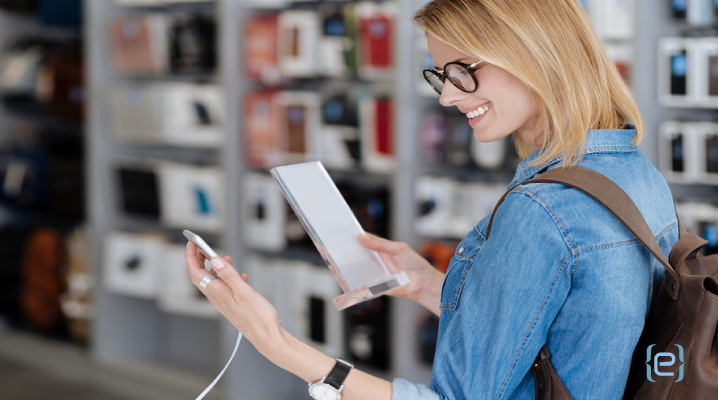

Modern retailing is becoming less about location and more about customer experience. That means having the basics, like up-to-date credit card terminals, is expected now just to be in the game. To compete effectively, retailers must provide more. Often, for smaller retailers keeping up with technology is the key.
Retail technology (the technologies employed by retailers in their stores) is changing fast. Smaller retailers are finding it hard to keep up with innovations employed by retail giants, such as digital display systems, beacons to track shopper behavior and sophisticated analytics.
With so much on their plates, many store owners just don’t follow retail technology market trends. Or, they think that they can’t afford the technology. Those that seek sound advice and technical know-how are more likely to stay current and hence, more competitive.
Flagship Store Tech
Flagship stores—bigger, more impressive stores that showcase a retailer’s brands—lead the way with retail technology. Some offer interactive games, numerous digital screens, exclusive tech accessories, or may personalize merchandise on the spot.
Many larger stores now use cell phone Wi-Fi or Bluetooth beacons to triangulate a shopper’s position. Customers don’t have to login to the store’s Wi-Fi for the technology to work. Surprisingly, it does if they just have their device Wi-Fi or Bluetooth turned on.


Audio Branding
We have corporate customers that deploy audio branding for their bathrooms. They found that if you play music in the bathrooms, people spend less time away from shopping. Audio branding can also be found in store elevators, customer apps and on digital displays.
Many locations use audio branding to create a sense of fun or evoke a particular decade. Johnny Rockets plays 1950’s music and Forever 21 plays tunes geared to a younger crowd. The music drives the experience.
You may have had a great experience at places where they were playing music, and you might have stayed there longer. At the ones that don’t, you tend to walk in, do what you came for and leave. Your ears are not being entertained, much like your eyes.
Retail Technology Basics
What technologies are must haves for retailers today? Consider this list as covering the major bases:
- Security – Retailers need up-to-date cyber-security technology to block hackers who employ sophisticated technologies of their own, like keystroke loggers and RAM scrapers to collect credit card numbers and other data.
- PCI compliance – Having the right payment technology, including proper installation is required by all the major credit cards. PCI compliance helps protect today’s chip and PIN cards and consumers.
- Customer Relationship Management (CRM) – Retailers need to collect data to improve the customer experience. Retailers shouldn’t have to ask your size again. And, they must be ready to suggest products and alternatives when you walk in the store.
- Network Infrastructure – To facilitate Wi-Fi inspiration, a modern computer network with up-to-date security and customer Wi-Fi is a must. Customers today want to check alternatives and get ideas while in the store.
Taking it Further
Retailers who want to stay ahead of what’s taking place in the store should track and respond to key performance indicators (KPIs). These include metrics like:
- Open on time
- Staffed properly
- Clean and pleasant
- Customer browsing time
- Traffic walking by and coming in
KPI’s are easy to measure online, but more difficult at brick and mortar locations. To use KPIs effectively, traditional retailers need technology like traffic counters and beacon tools.
Those that want to increase customer loyalty must adopt omni-channel retailing. That means standardizing the customer experience no matter which method they use to shop. Prices should be consistent across channels and returns allowed to any source.
Smaller Retailers Keeping Up with Technology
When seeking to update small business retail technology, remember that technologies vary based on the type of store. Choose a professional that knows your industry. A shoe store should look for someone that fits their criteria, knows retail and has worked with shoe companies.
That could be a knowledgeable friend or listening to a retail technology podcast. But, choose a professional who’s skilled at what you need and can help you prepare for the future. Without a technology plan, you’re guaranteed to fail.
As the #1 small business retailer-focused MSP in the U.S., eMazzanti Technologies is a one-stop shop for retail technology, including network infrastructure and management, cloud services, customer Wi-Fi, POS systems, PCI compliance, payment technology, payment gateways, merchant services, eCommerce and network security.
Recent Posts
Enhancing Your Professional Tone with Emojis in Business Digital Communication
Discover how emojis can enhance your business communication, adding personality and emotion to digital interactions.
Data Breaches Brand Reputation: How Security Slip-ups Can Shatter Consumer Trust
Discover how data breaches impact brand reputation and learn strategies to rebuild trust and strengthen…
Future Communication Technologies: Bridging Worlds with Quantum Leaps and Virtual Handshakes
Explore the future of communication with advancements in AI, 5G, and quantum technologies, reshaping global…
Future Cyber Security Legislation: What to Expect in 2025 and Beyond
Discover the upcoming trends in cyber security legislation, focusing on AI, IoT, and cross-border data…
Cyber Security Customer Data: Shielding Your Digital Gold Mine from Hackers
Protect your business from rising cyber threats with strong cybersecurity practices to safeguard customer data…
Big Data Marketing Strategies: Unlocking Customer Insights for Personalized Campaigns
Discover how big data marketing strategies can unlock customer insights and enhance personalized campaigns for…


